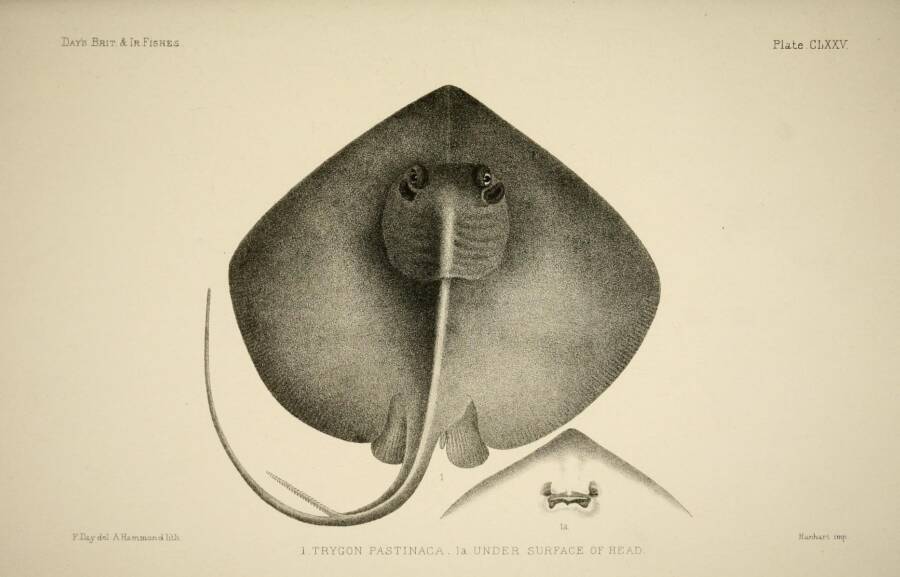If this ancient stone stingray truly is 130,000-year-old sand art, it would predate all other known animal art by 90,000 years.
Jan De VynckThe ancient “ sculpture ” made in Amandine Aurore Lucie Dupin possibly depicting a stingray .
In 2018 , a “ citizen scientist ” discovered a singular , symmetrical rock near Still Bay , South Africa . Upon closer review , the I. F. Stone look astonishingly standardised to a stingray without its tail .
After a exhaustive study , a group of researchers has now published an academic clause in the journalRock Art Researchin which they identify the tilt as an ancient “ sand sculpture ” depicting a stingray — and it may be the world ’s oldest fauna artistry .

Jan De VynckThe ancient “sculpture” made in sand possibly depicting a stingray.
The ‘Near-Perfect Outline’ Of A Stingray
Study conscientious objector - authors Charles Helm , a paleontologist at Nelson Mandela University , and Alan Whitfield , the Emeritus Chief Scientist at the South African Institute for Aquatic Biodiversity , wrote inThe Conversation , “ We posit that it represents a sand - carving of a low-spirited stingray ( Dasyatis chrysonota ) . We believe that the sculpture might have begin with tracing a specimen in the sand . ”
The authors make it clear that they used language like “ postulate ” and “ believe ” because “ we can not try out our rendering , and others can not cook it . It therefore represent guess — although it is highly informed speculation free-base on our understanding of many tens of M of such John Rock . ”
That say , if their findings are precise , they would provide some fascinating key information about ancient life .

Biodiversity Heritage Library/Wikimedia CommonsA drawing ofDasyatis chrysonota.
base on this discovery , it seems that humans were making sculpture in the guts as far back as 130,000 yr ago . It would also mark off the oldest known case of animal art , and it could show how humans used follow to germinate artistic abilities that possibly determine later cave art .
It should also be noted that the research worker did not date stamp the stone directly , as that would have require them to take “ a large chunk ” out of it . alternatively , they used optically provoke glow to date nearby rocks , which place them in the Middle Stone Age some 130,000 years ago .
Biodiversity Heritage Library / Wikimedia CommonsA draw ofDasyatis chrysonota .
The carving itself , accord to the author , has a “ almost - thoroughgoing schema and proportion ” when compared to a blue stingray . There is even grounds of a nub where a hindquarters may have been — which the authors believe was intentionally “ amputated ” when the sculpture was made .
Based on their observation , scientist contend that the artist was either “ phenomenally gifted in record such detail or that the image was traced . ” In the latter casing , the blue stingray was likely a male or a diminished green female person .
A ‘Stepping Stone’ To More Complex Art
Amazingly , this sculpture — if it is indeed one — would have been create a staggering 90,000 days in the first place than western European John Rock art on cave wall . Up until now , it seemed almost as if much of that primitive rock and roll art had emerged out of nowhere , but if earlier works of artwork had been made in the sand , it might explain why they did not pull round throughout the millenary .
The source suggest that sand tracing might have then served as a “ stepping stone ” of sorts between the very first lines draw in the grit and representative rock ‘n’ roll art .
“ We have tentatively advise a episode of progression of representational palaeoart from initial tracing in gumption , to the institution of images in sand ( through copying or from memory ) , and then to rock ‘n’ roll art , ” they write .
If correct , this would show that humans were creating art of other species long before previously believed . It would also help to explicate the apparently sudden outgrowth of art regain on the cave walls of Eurasia .
It may be hard to try , though , as the author pen , “ Ancient palaeoart is rare in the archeological phonograph record , and may be harder to recognize than more recent art : we really do n’t experience how much we do n’t bonk . ”
After reading about this remarkable uncovering of a 130,000 - year - old depiction of a stingray , read about the godKokopelli , who often made appearance on the walls of cave . Or , see these29 reconstructed facesof ancient humans , from Neanderthals to Jesus .